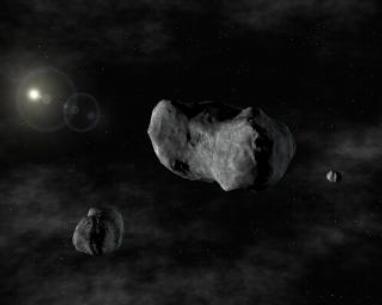Asteroid 87 Sylvia, known since 2001 to be part of a double system, has just gotten more interesting. A team of astronomers at the University of California at Berkeley and the Observatoire de Paris have now established that the asteroid is actually part of a triple system, the first ever discovered. Using data from the European Southern Observatory’s Very Large Telescope array in Chile, the team found two small moons in nearly circular orbits.
 Astronomical names are always a challenge, but in this case naming comes easy. 87 Sylvia was named for Rhea Sylvia, the mother of the founders of Rome. Thus it made perfect sense for Berkeley’s Franck Marchis to propose Romulus and Remus as the names of the moons. The suggestion has already been approved by the International Astronomical Union.
Astronomical names are always a challenge, but in this case naming comes easy. 87 Sylvia was named for Rhea Sylvia, the mother of the founders of Rome. Thus it made perfect sense for Berkeley’s Franck Marchis to propose Romulus and Remus as the names of the moons. The suggestion has already been approved by the International Astronomical Union.
Image: Artist’s conception shows twin moonlets, Romulus and Remus, orbiting the large main-belt asteroid 87 Sylvia. Credit: European Southern Observatory.
Calling them ‘moons’ should not obscure the fact that these are tiny objects. 87 Sylvia, which orbits between Jupiter and Mars roughly 3.5 AU from the Sun, is potato-shaped and measures some 380 x 260 x 230 kilometers. Romulus orbits about 1360 kilometers from the asteroid and measures a scant 18 kilometers across, while Remus is a tiny 7 kilometers in diameter.
The observations of these tiny satellites help astronomers calculate the mass and density of 87 Sylvia. It seems to be composed of water ice and rubble from an ancient asteroid and could, according to co-discoverer Daniel Hestroffer at the Observatoire de Paris, be composed of up to 60 percent empty space. From an ESO news release:
“It is most probably a “rubble-pile” asteroid”, Marchis added. These asteroids are loose aggregations of rock, presumably the result of a collision. Two asteroids smacked into each other and got disrupted. The new rubble-pile asteroid formed later by accumulation of large fragments while the moonlets are probably debris left over from the collision that were captured by the newly formed asteroid and eventually settled into orbits around it. “Because of the way they form, we expect to see more multiple asteroid systems like this.”
Centauri Dreams‘ note: The Romulus and Remus story comes from the Roman historian Livy (d. 17 A.D.). The complete background is nicely summarized here, but the charm of the story comes from the abandoned twins being nursed by a she-wolf after being set adrift on the Tiber. Taken in by a shepherd, they eventually built their settlement on the Palatine Hill. Romulus, having killed Remus in a dispute, made himself king of the city. Marchis says he chose Romulus for the larger moon because of the name’s derivation from the Greek word for strength, whereas Remus (which is related to Latin remorari, meaning to linger or delay) seemed appropriate for the small, inner moon.
The paper is Marchis, F., Descamps, P., Hestroffer, D. et al., “Discovery of the first triple asteroidal system 87 Sylvia,” Nature 436 (August 11, 2005), pp. 822-824. The Observatoire de Paris press release is also available, and so is this release from UC-Berkeley, which contains links to some interesting animations of the triple system.

